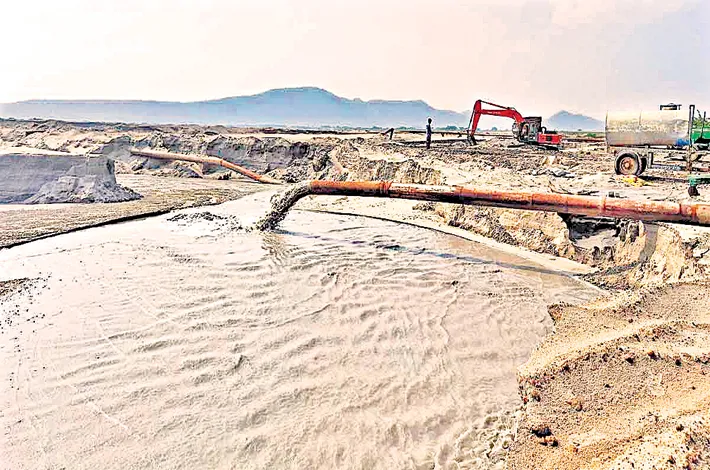Ash Mountains
14-11-2025 12:00:00 AM

Power turns polluter in Telangana
At Bhadradri Thermal Power Station (BTPS), during October alone, the plant produced 39,463 metric tonnes of ESP dry ash and 9,865 metric tonnes of wet ash. Out of this, only 14,617 tonnes of dry ash and a meagre 24.31 tonnes of pond ash were utilized by local factories
metro india news I hyderabad
Telangana’s thermal power plants — once the backbone of its electricity grid — are fast turning into a ticking environmental time bomb. The coal-fired units that light up millions of homes are now choking under their own by-product: mountains of ash growing taller each year. Experts warn that unless swift action is taken, these grey giants could soon erupt into a full-blown ecological crisis.
Currently, Telangana GENCO operates thermal power plants with a combined installed capacity of 5,580 MW. According to official data available till last month, these plants have already accumulated nearly 10 crore metric tonnes of ash. The highest volumes are seen at the Kothagudem units (Stages V, VI, and VII), which collectively generate 1,800 MW. As of September, Stage V alone has produced 8.92 crore metric tonnes of ash stored in massive ponds, while the 500 MW plant under Stage VI generated 12.51 lakh metric tonnes, and Stage VII added another 33.55 lakh metric tonnes. The scenario is similar at Kakatiya, Bhadradri, Yadadri, and Ramagundam, where fly ash and pond ash continue to amass in enormous quantities.
By the end of October, Telangana’s total accumulated ash was estimated to have exceeded 10 crore metric tonnes. At this rate, the growing ash heaps have already consumed nearly 4 square kilometers of land area around Kothagudem, transforming open grounds into grey wastelands.
Minimal industrial usage
Despite such massive accumulation, the actual utilization of this ash remains negligible. Only a few cement, brick, and construction industries are using small portions of the waste. For instance, by September, Kothagudem’s Stage units had supplied just 2,33,368 metric tonnes of ash to cement and brick industries — a fraction of the total generated. Similarly, only 1,42,541 metric tonnes of ash from the same units were put to industrial use.
At Bhadradri Thermal Power Station (BTPS), during October alone, the plant produced 39,463 metric tonnes of ESP dry ash and 9,865 metric tonnes of wet ash. Out of this, only 14,617 tonnes of dry ash and a meagre 24.31 tonnes of pond ash were utilized by local factories. That means out of nearly 48,000 tonnes produced in a single month, over 33,000 tonnes were left unused. As of October-end, BTPS alone has accumulated 71.40 lakh metric tonnes of ash in storage.
At present, the ash generated by thermal plants is being used almost exclusively by cement and brick factories. But their consumption is too small compared to the massive quantities being produced every month. With several lakh tonnes of ash generated monthly, the limited industrial demand barely makes a dent in the overall buildup. The government, however, seems to lack a clear strategy for large-scale or diversified utilization.
Need for a comprehensive study
Experts stress the urgent need for a comprehensive assessment of how this huge volume of ash can be used effectively. The responsibility lies in finding sustainable ways to repurpose it without posing risks to the environment. Already, communities living near thermal plants — like those around Bhupalpally’s Kakatiya Thermal Power Plant (KTPS) — have been struggling with health and pollution issues caused by fly ash. Similar conditions exist around Kothagudem and may soon affect the Yadadri region as well.
It is crucial to explore whether the ash can be effectively used in road construction, filling mined-out pits, or other infrastructure works without harming the ecosystem. Engineers, environmentalists, and technical experts must work together to design innovative methods for recycling this waste material on a large scale.
Exploring new avenues
Telangana is witnessing rapid infrastructure growth, with thousands of kilometers of new roads being laid across the state. Utilizing fly ash in road construction could offer a viable solution. Additionally, it may be possible to use this ash to fill abandoned mining pits, ensuring environmental safety and resource reuse. Studies are also needed to evaluate its potential use in building materials beyond bricks and cement — including large-scale construction and housing projects.
If the current trend continues, both the environment and nearby communities could face serious consequences. The government must therefore step in with proactive policies — offering incentives and subsidies to industries that use more fly ash in their production processes. Simultaneously, awareness campaigns should be launched to educate industries and the public about the benefits of ash utilization.
Moreover, government-led infrastructure projects such as road building and civil works should consider mandatory inclusion of fly ash in their materials, wherever technically feasible. Offering rebates or special provisions for such initiatives could accelerate large-scale usage.
Without timely action, the unchecked rise in ash deposits will continue to threaten both public health and environmental stability. What powers Telangana today could soon pollute it tomorrow — unless the “grey mountains” of ash are transformed into a resource rather than a risk.








